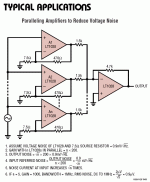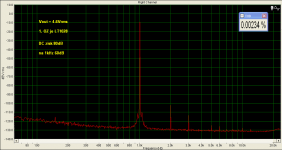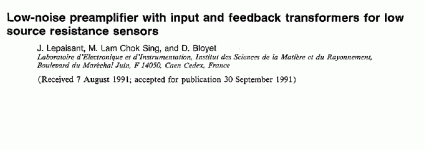john curl said:Scott, I did NOT invent Rbb'. I just found LOW Rbb' in devices that did not note it on the spec sheet. I have found several other devices from various manufacturers over the decades that are even better, without ANYTHING about it on the engineers spec sheet.
When the Levinson JC-1 was first introduced at the AES in 1973, I was told that it was impossible to achieve such low numbers as 0.4nV/rt Hz without a transformer. Well, I did it then, and I do it now, AND that is 2.5 times quieter than your AD797. You have a ways to go, Scott.
This point has grown tired, it is trivial to make an input device with that low rbb. IC op-amps that idle at 1 Watt have no commercial value except to a few hundred users. We already know how to make an op-amp with .2 nV of noise, please ante up a few thousand dollars for each to cover the costs of masks and wafers.
PMA said:
What is syn08 saying?
Well, here's what syn08 says:
1. Edmond needs to refresh his SNR understanding. Of course there's noise around the 300ohm resistors, but who cares. The signal is already up in the FET stage.
2. I couldn't care less about distortion. I have measured around 0.01% and that's more than a MC stage needs forever and after. Take a look at any pro MC stage, usually they may not even mention THD.
3. Regarding John's obsession with the 797 output current: what he is actually overseen is that the gain of the input stage fells over 2222Hz, as part of the RIAA correction is implemented here. I just finished measuring the 797 output current for a input equivalent to 50cm/s ref 0.5 mV (which is the max I ever heard about). The 797 output current is remarkably constant in 20Hz-100KHz at 25mA. Is this bad? No, to me is perfectly acceptable for a high current opamp as 797. Anyway, a buffer won't do any better.
gerhard said:... or do it as shown in the Lt1028 data sheet,
where they simply parallel half a dozen of LT1028 OpAmps.
That's so old and boring.
Right, I was thinking I could sum a 100 SSM2019's and get bragging rights for .09nV.
You must be sitting close to the source... 🙂
But then, this problem could be solved with just
one layer of NiCr and maybe another metal layer
for existing wafers.
and, since this thread is most interesting whenever it goes astray:
http://arxiv.org/abs/physics/0503012
and www.rubiola.org , where it stems from.
(for them engineer types)
regards, Gerhard
But then, this problem could be solved with just
one layer of NiCr and maybe another metal layer
for existing wafers.
and, since this thread is most interesting whenever it goes astray:
http://arxiv.org/abs/physics/0503012
and www.rubiola.org , where it stems from.
(for them engineer types)
regards, Gerhard
syn08 said:
2. I couldn't care less about distortion. I have measured around 0.01% and that's more than a MC stage needs forever and after. Take a look at any pro MC stage, usually they may not even mention THD.
MC preamp :
Attachments
Gerhard, this is an 'okay' sort of design that is not too special. It will work, it will be quiet, but without feedback to the input, it might be limited in utility.
Still, the principles are sound, and it is important that people know how to do this sort of thing. It is interesting that many professors and their textbooks do NOT know how to do PRACTICAL low noise design well.
Still, the principles are sound, and it is important that people know how to do this sort of thing. It is interesting that many professors and their textbooks do NOT know how to do PRACTICAL low noise design well.
The professor who wrote the article is wonderful! Our kind of guy! He pushes the limits, rather than makes excuses.
gerhard said:
You must be sitting close to the source... 🙂
But then, this problem could be solved with just
one layer of NiCr and maybe another metal layer
for existing wafers.
and, since this thread is most interesting whenever it goes astray:
http://arxiv.org/abs/physics/0503012
and www.rubiola.org , where it stems from.
(for them engineer types)
regards, Gerhard
These guys did OK.
Attachments
PMA said:
MC preamp :
Try again at 20KHz, without RIAA. It will be worse than 0.01%
Transformers can be good for low noise input stages. It is just that they are really expensive to get a really great one.
This point has grown tired, it is trivial to make an input device with that low rbb. IC op-amps that idle at 1 Watt have no commercial value except to a few hundred users. We already know how to make an op-amp with .2 nV of noise, please ante up a few thousand dollars for each to cover the costs of masks and wafers.
JF, CH et al are not semiconductor guys. Unfortunately, they don't get the economics or the pressures in the industry. Like you say Scott, its quite easyy to do a lot of the stuff we like doing as audio guys, but the payback is not there.
JF, CH et al are not semiconductor guys. Unfortunately, they don't get the economics or the pressures in the industry. Like you say Scott, its quite easyy to do a lot of the stuff we like doing as audio guys, but the payback is not there.
Most people can't afford Porsches or Mercedes either, but that doesn't mean that we should glorify Fords and Renaults.
john curl said:Most people can't afford Porsches or Mercedes either, but that doesn't mean that we should glorify Fords and Renaults.
You make a valid point here John, American built Fords are indeed a pile of crock, but once you have lived in and driven European designed models you will appreciate that not every thing with a high price/name is better.
http://arxiv.org/abs/physics/0503012
Regards
James
Input cables should not PTFE-insulated because of piezoelectricity (see the review paper [Fuk00]).
Regards
James
Indeed, and optimally the transformer should be optimised for the MC cartridges DCR and output level.
I am going to try the new Lundahl transformer LL1931 as soon as I get them.
Sigurd
I am going to try the new Lundahl transformer LL1931 as soon as I get them.
Sigurd
john curl said:Transformers can be good for low noise input stages. It is just that they are really expensive to get a really great one.
Why measure without the RIAA? That is what we need to have there.....
Sigurd
Sigurd
syn08 said:
Try again at 20KHz, without RIAA. It will be worse than 0.01%
I also had made that measurement (i.e. full linear gain, about 80dB, without RIAA freq. resp.), it had about 0.01% quite exactly. Anyway, not much reason to do it, I agree. Especially when RIAA FB caps add heavy loading for the unbuffered opamp, like in case of syn08's GPP.
PMA said:I also had made that measurement (i.e. full linear gain, about 80dB, without RIAA freq. resp.), it had about 0.01% quite exactly. Anyway, not much reason to do it, I agree. Especially when RIAA FB caps add heavy loading for the unbuffered opamp, like in case of syn08's GPP.
Build it, simulate it, whatever, you'll reach the same conclusion: in this particular case a buffer at the output of AD767 won't do squat. In fact, many buffers are even worse than AD797 when it comes to output current capability.
A worst case (overload, 50cm/sec vinyl pops) 25mA at the output of an AD797, anywhere in 20Hz-100KHz is very good. Under "normal" operations, the output current is in the low mA range.
- Status
- Not open for further replies.
- Home
- Amplifiers
- Solid State
- John Curl's Blowtorch preamplifier


